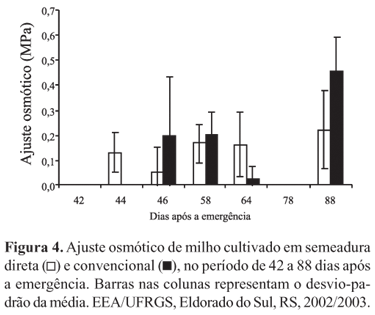Maize is a very sensible crop to water deficit, which is a frequent cause of reduction in its grain yield. The objective of this work was to verify the occurrence of osmotic adjustment in maize cultivated in different soil management systems and water availability. The maize was cropped in no-tillage (NT) and conventional tillage (CT), with irrigation and no-irrigation. For measurements of minimum leaf water potential, a pressure chamber was utilized. Osmotic adjustment was calculated as the difference between osmotic potentials at full turgor, in irrigated and non-irrigated plants. Highest values of minimum leaf water potential were found in plants cropped in NT, as a response to the highest soil potential on this cropping system. Pressure potential and the osmotic potential at full turgor were reduced as a response to water deficit, resulting on an osmotic adjustment in both cropping systems, with a highest intensity in the CT system. Minimum leaf water potential showed sensitivity to water deficit, which makes it a good indicator of plant water status on maize. Maize crop showed tolerance to water deficit through the mechanism of osmotic adjustment.
Zea mays; leaf water potential; water deficit; no-tillage






